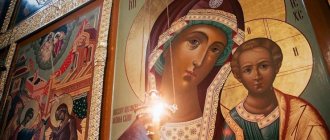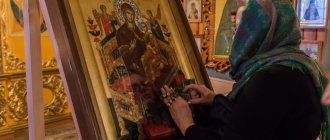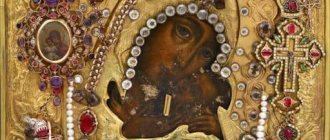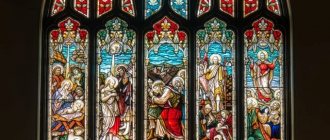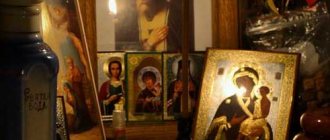Prayer to the Most Holy Theotokos before the Icon of Her “Kazan”
Oh, Most Holy Lady Theotokos! With fear, faith and love, falling before Your honest icon, we pray to You: do not turn Your face away from those who come running to You, begging, Merciful Mother, Your Son and our God, the Lord and May Jesus Christ keep our country peaceful and His holy Church unshakable May he preserve and deliver from unbelief, heresies and schism. There are no other help, no other hope, except You, Most Pure Virgin: You are the all-powerful Helper and Intercessor of Christians. Deliver also all those who pray to You with faith from the falls of sin, from the slander of evil people, from all temptations, sorrows, illnesses, troubles and from sudden death; Grant us the spirit of contrition, humility of heart, purity of thoughts, correction of sinful lives and the remission of sins, and all, gratefully chanting Your greatness and mercy, manifested over us here on earth , let us be worthy of the Kingdom of Heaven and there, together with all the saints, let us glorify the most honorable and magnificent name of the Father and the Son and the Holy Spirit forever and ever. Amen.
Troparion to the Most Holy Theotokos before the Icon of Her “Kazan”
voice 4
O zealous intercessor,/ Mother of the Lord Most High,/ pray for all Thy Son Christ our God,/ and cause all to be saved,/ to those who flee to Thy sovereign protection./ Intercede for us all, O Lady Queen and Ruler chitsa, / like in misfortunes and sorrows, and in illness, burdened with many sins,/ standing and praying to You with a tender soul/ and a contrite heart,/ before Your most pure image with tears,/ and the irrevocable hope of those who have in You,/ delivered laziness of all evils, / grant useful to everyone, / and save everything, Mother of God Virgin // For You are the Divine protection of Your servant.
Kontakion to the Most Holy Theotokos before the Icon of Her “Kazan”
voice 8
Let us come, people, to this quiet and good refuge, / to the quick Helper, ready and warm salvation, the protection of the Virgin, / let us hasten to prayer and strive for repentance: / for there is no shortage for us the aching mercy of the Most Pure Mother of God, / advances to help, and delivers from the great troubles and evil // good and God-fearing servants.
The Greatness of the Most Holy Theotokos before the Icon of Her “Kazan”
We magnify Thee,/ Most Holy Virgin,/ and honor Thy holy image,/ from which flows gracious help// to all who flow to it with faith.
Story
Once revealed to the distant outskirts of the country, now this is perhaps Russia’s most beloved icon of the Mother of God. Kazan is a kind of symbol, the hope of the country during trials, a sign of the Most Pure One’s love for Her “home,” which Rus' has always been called.
8
July
1579
In the city of Kazan, conquered by Tsar Ivan IV less than 20 years earlier, a miraculous image of the Mother of God appeared.
No one expected this event or expected it. Not long before there was a terrible fire that destroyed a significant part of the then wooden city. Local Muslims openly said: God is punishing the Orthodox who came to their ancestral land. The faith of Christians became “a parable and a reproach,” according to the words of the Kazan priest Ermolai (in the future, the primate of the Russian Church, Hermogenes).
From the bowels of the earth
Iconography: Kazan Icon of the Mother of God Dates: XVII century. Second quarter of the 17th century. Origin: From the Spaso-Prilutsky Monastery near Vologda. Material: Wood, gesso, tempera. Dimensions of the icon: height 37.5 cm, width 32 cm. Icon in frame. In the middle there is a depiction of the Mother of God and Child. In the margins are images of Saints Gurias and Barsanuphius. VOKM 5474 ©Vologda State Historical, Architectural and Art Museum-Reserve.
Then the Kazan archer, whom the “Legend” about the acquisition of the image calls “a certain simple husband,” Daniil Onuchin, was rebuilding his house in the conflagration. Busy with construction, he and his wife did not immediately pay attention to the stories of their daughter, 10-year-old Matrona. She kept repeating that the Mother of God Herself appeared to her in a dream, commanding her to find her holy icon in the conflagration.
The third, and last, appearance of the Most Pure One turned out to be formidable: the Mother of God directly demanded that Her icon be found. Only after this did the girl’s mother rush first to the priests, and therefore to the bishop himself. But the church authorities also did not pay attention to the child’s words. No matter how much the woman told her neighbors about everything that happened, just passers-by on the street, they all, as the legend says, “marveled at her words and walked away without paying attention to her speech.”
Then Matrona and her mother themselves began excavations at the site of the burnt house. Here, at about a meter deep, they found an icon neatly wrapped in cloth. Apparently, having lain in the ground for years, it, however, looked clean, as if it had just been painted by a master.
History of the Kazan Icon. Finding a shrine
The image of the Mother of God appeared in Kazan in 1579, when this city could still hardly be called Russian. Only 27 years have passed since the capture of Ivan the Terrible by his troops in 1552, and even less since the founding of a separate diocese of the Russian Orthodox Church in 1553. The local population also had little sympathy for such a great event, since it was predominantly Muslim. Moreover, on the eve of the apparition - in June 1579 - the city was engulfed in a terrible fire, and many local residents considered this to be the malicious intent of Christians. Nevertheless, it was in this city and in this turbulent time that the Mother of God revealed Her honest image.
Kazan Bogoroditsky Monastery, Kazan.
Kazan miracle: first healings
People came running to the place of the extraordinary event, finally the priests came, and then the Kazan ruler Jeremiah. In a procession of the cross, the new shrine was carried to the nearby church of St. Nicholas. Many Orthodox Christians, crowding each other, tried to see the image and touch it. And not in vain: healings began to flow from the icon even then, on the very first day after its appearance.
Miraculously, two blind men, God's servants Joseph and Nikita, received sight. At the same time, Joseph, instead of thanking the Lady, “attempted to ask for silver again,” trying to extract more benefit from what happened. Patriarch Hermogenes, a participant in the discovery of the holy image, writes that Joseph immediately lost his sight, only “from ignorance for the sake of his small path to see.” And the people, shocked by the miracle and the quick admonition of the ungrateful man, had even greater faith in the shrine.
In total, during the first days after the appearance of the shrine, there were 16 recorded miracles. Most of these were healings from blindness, as well as relaxation (paralysis), and leg diseases.
Guardian of the country
Already since 1579, the list of icons has been known in the capital. It is believed that they made it for Tsar Ivan IV, who learned about the miracle. By his order, a convent was built at the site of the appearance of the image. The first to be tonsured here were Matrona (in monasticism - Moor) and his mother. But still the holy image remained almost until the end of the 16th century. was revered only as a local shrine.
Only in 1594 did a legend appear about the discovery of the icon, written for Emperor Theodore Ioannovich by then Metropolitan Hermogen of Kazan, who once carried the found shrine during the first religious procession. 8 years later, already at the height of the Time of Troubles, the Kazan Bishop, by the will of God, became the Patriarch of the Russian Church. It is from St. Hermogenes is credited with the beginning of the all-Russian veneration of the holy image:
- by his order, a list of Kazan (1611) was brought to the walls of the capital captured by the Poles, where the people’s militia was stationed; the image was greeted without respect; many later said that the consequence of rejecting the help of the Mother of God was the defeat of the people’s militia, which was trying to liberate Moscow;
- the list of the icon became the “Hodegetria” of the second militia of Prince Dimitry Pozharsky; On November 4 , 1612, his troops, presenting the shrine, entered Red Square.
By this time St. Hermogenes was no longer alive: he suffered martyrdom at the hands of the Polish interventionists, who starved the saint to death. And Kazan has firmly taken its place among the main shrines of the Russian Church. For her list, a temple dedicated to the miraculous image was built on Red Square.
“Zealous Intercessor, Mother of the Lord Most High!..”
November 4 – celebration in honor of the Kazan Icon of the Mother of God
Of the icons of the Mother of God revered in the Russian Orthodox Church, not one is as widespread as the Kazan icon. In numerous miraculous lists from the Kazan Icon, the Most Pure Mother of God, Patroness of the Orthodox Russian people, is glorified in Rus'. Let us recall the poem “Before the Icon of the Kazan Mother of God” by the abbess of the St. John the Baptist Leushinsky first-class convent, Abbess Taisiya (Solopova, 1842-1915):
How good it is in Your temple, Lady! How sweet and light to the soul! Everyone breathes freely, calmly in it, The heart is light and warm!
As if You Yourself, O Mother of All Sings, You Yourself are standing here with us; Mother's warm love for people You look at everyone with compassion!
And Your face, shining with Divine glory, Silently speaks to the hearts: “Come, pray to Me, who listens to you, I will give you all joy!
Pray, wretched, poor, orphaned ones, because I am your Mother and Cover! Pray too, you who are happy in this world, Know love in this happiness!
Pray, too, you, burdened with sin, I have been waiting for your prayers for a long time; And tears of repentance, I will hear them and accept them!
Pray too, you decrepit, frail elders! Pray too, you, flower of youth, Pray too, dear little ones, I will protect you all from troubles!..”
Oh, Merciful Mother Most Pure! Your love for us is immeasurable; You are our most swift Intercessor in sorrows, You are our Mother and Cover!
ABOUT! do not leave us, beloved Mother, make us pray to you; And with warm faith, accept the prayers of sinners offered to You!
***
The Kazan Image is a copy of the ancient Blachernae icon and is of the iconographic type of the icons called Hodegetria the Guide. Inspired by the Blachernae Icon of Hodegetria, which is believed to have been painted by the Evangelist Luke during the life of the Mother of God, the ancient Russian monk-icon painter created his own version-list of the holy Image. At the place of its Appearance, this Image became known as the Kazan Icon of the Mother of God. Its iconography, compared to the Blachernae icon, is slightly changed. The Russian Image of the Mother of God can always be recognized by its warmth, softening the royal severity of the Byzantine prototypes. What else distinguishes the Russian Image from the classic version of this type? The shoulder-length image and the tilt of the head of the Mother of God towards the Child. Thanks to this, their faces seem to come close to those praying. And at this moment we touch upon the mystery of the Incarnation. A slight turn of the Mother of God’s head directs our attention to Her Divine Son. In this icon, the Savior does not sit on the hand of the Mother of God, but stands to Her left. His right hand is raised in blessing. The Infant God blesses the Mother of God with his hand, and in Her person - all Christians.
***
By the beginning of the twentieth century, the icon of the Kazan Mother of God was in every Russian home - from a peasant hut to the royal chambers. Particularly revered were two miraculous copies from the Kazan Icon of the Mother of God, which twice accompanied the Russian army in the fight against foreigners: Moscow and St. Petersburg.
***
When the army gathered by Minin and Pozharsky from the Volga lands annexed by Grozny approaches Moscow, occupied by the Poles, it will be overshadowed by a copy of the Kazan Icon, revealed in the city of Kazan on July 21, 1579. And at this time, in the icy casemate of the Chudov Monastery in the Kremlin, the ideological inspirer of the resistance, Patriarch-martyr Hermogenes (Hermogenes), will betray his soul to God. It was he, the former Kazan priest Ermolai, who once compiled for the Sovereign “The Tale of the Appearance of the Miracle-Working Icon of Our Most Holy Lady Theotokos and Ever-Virgin Mary, which was in Kazan City...”. In the besieged Kremlin at that time, Archbishop Arseny of Elasson (later Archbishop of Suzdal; † 1626) who had arrived from Greece, seriously ill from shocks and experiences, was in captivity at that time. At night, Saint Arseny’s cell suddenly illuminated with Divine light, he saw St. Sergius of Radonezh, who said: “Arseny, our prayers are heard; through the intercession of the Mother of God, God’s judgment on the Fatherland was transferred to mercy; "Tomorrow Moscow will be in the hands of the besiegers and Russia will be saved." To confirm the truth of the prophecy, the archbishop received healing from his illness. The saint sent news of this joyful event to the Russian soldiers. The next day, October 22/November 4, 1612, Russian troops, inspired by the vision, won a major victory and took China Town, and 2 days later the Kremlin. On Sunday, October 25, Russian squads solemnly, with a procession of the Cross, went to the Kremlin, carrying the Kazan Icon. At the Place of Execution the procession of the Cross was greeted by Archbishop Arseny, who emerged from the Kremlin and carried the Vladimir Icon of the Mother of God, which he had preserved in captivity. Shocked by the accomplished meeting of two miraculous icons of the Mother of God, the people prayed to the Heavenly Intercessor with tears.
***
The first Romanov on the Russian throne, the young sovereign Mikhail Feodorovich, established the second celebration of the Icon of the Mother of God of Kazan on October 22 (November 4) in memory of the liberation of Moscow and the salvation of Russia. Nowadays this holiday is celebrated not only by the Mother Church, but also revived as a state holiday,
***
The cathedral-monument in honor of the Kazan Icon of the Mother of God, with which the miraculous deliverance of Russia from the Polish invasion was associated, was built at the expense of Prince Dmitry Mikhailovich Pozharsky in the 1620s. The miraculous “Kazan” Icon of the Mother of God, the main military shrine of the militia of Minin and Pozharsky, was placed in the cathedral, one of the first copies of the Image of the Mother of God revealed in the city of Kazan. Since its construction, the cathedral has become the most important temple of the Mother See. Among the Moscow clergy, his rector occupied one of the first places. After the fire of 1635, instead of a wooden cathedral, a stone one was built at the expense of the first tsar of the Romanov dynasty, Emperor Mikhail Fedorovich. Consecrated by Patriarch Joseph on October 15, 1636. By 1650, a new porch and bell tower were built in front of the cathedral, and at the end of the 17th century a front porch was built. After the completion of the construction of the stone Kazan Cathedral, a smooth wooden pavement was made from it to the Execution Place. It was called the Red Bridge, and near the temple - Red Square. So the cathedral gave the name to the main square of Moscow. After the revolution, the cathedral was not immediately closed. In 1925-1930, under the leadership of architect P.D. Baranovsky, it was restored at the expense of the parish. But in 1936, the Kazan Cathedral was nevertheless closed and dismantled. Restored in 1993. Consecrated on November 4 by His Holiness Patriarch of Moscow and All Rus' Alexei II.
***
Pilgrims flock daily not only from Moscow and the Moscow region, but also from different cities of Russia, from -abroad. This Image of the Blessed Virgin Mary was transferred to the cathedral in the late 1930s, when the cathedral in Dorogomilov was destroyed. And before that, they prayed in front of this shrine in the Kazan Cathedral on Red Square. ...During the Great Patriotic War, the Patriarchal Locum Tenens Metropolitan Sergius (Stragorodsky), elected His Holiness the Patriarch in 1943, prayed in the Epiphany Cathedral in front of the Miraculous Kazan Icon for the granting of Victory to our people and the Fatherland. When the enemy approached Moscow, a religious procession was held in the capital with this Image of the Most Holy Theotokos.
***
The second revered list, the St. Petersburg list, which belonged to the Dowager Empress Praskovia Feodorovna, was transferred, among other shrines, by Emperor Peter the Great to the northern capital he was establishing, where it became one of the most important shrines of the city of St. Peter. In 1811, the Kazan Cathedral was built in honor of this Image. The following year, 1812, M.I. Kutuzov, appointed commander-in-chief of the Russian army by Emperor Alexander I, before leaving for the active troops, prayed in front of the St. Petersburg shrine and, through the laying of an icon on him, received the blessing of the Mother of God for the holy cause of fighting the invaders. From silver looted by the French and taken by the Cossacks, Kutuzov built a silver iconostasis in the cathedral - a gift from the Mother of God. The ashes of the glorious commander, known for his piety, rested under the arches of the Kazan Cathedral next to the miraculous Image of the Mother of God, who did not reject his prayers and, under his leadership, granted victory to the Russian army over the armies of Napoleon.
***
During the Great Patriotic War, when their strength was already running out, residents of the blockaded city on the Neva made a religious procession with the Kazan Icon of the Mother of God, which undoubtedly added resilience to the believing townspeople and helped them survive to the end.
***
The St. Petersburg copy of the Kazan Icon, which was located in the Prince Vladimir Cathedral during the Soviet years, returned to its place in the iconostasis of the Kazan Cathedral - after its restoration.
***
It is with the Kazan Icon that young people are blessed for their crown. It is this that is hung near children’s cribs, so that the gentle face of the Mother of God looks with love at our children and grandchildren and guides them to a righteous earthly life. We most often turn our eyes to the Kazan Icon in troubles and illnesses, crying out: “Distinuous Intercessor, Mother of the Lord Most High! Pray for all of Thy Son, Christ Our God, and cause all to be saved, seeking refuge in Thy sovereign protection. Intercede for all of us, O Lady, Queen and Mistress, who, in adversity and in sorrow and in illness, are burdened with many sins, standing and praying to You with a tender soul and a contrite heart before Your most pure image with tears, and those who have irrevocable hope in You for deliverance of all evils , grant useful to everyone, and save everything, Virgin Mary: for Thou art the Divine protection of Thy servant.”
All-Russian shrine
Subsequently, the icon became famous for its miracles of help at the most critical moments in the history of the state:
- a copy of the image, called “Kaplunovskaya”, at its location, the village of Kapluny, was transferred to the Russian army in 1709, on the eve of the Battle of Poltava; troops under the leadership of Emperor Peter I then won a brilliant victory over the Swedes; it was then that the idea of building a cathedral church in the new Russian capital, St. Petersburg, appeared;
- in 1812, Kazanskaya again took part in hostilities, this time during Napoleon’s invasion; November 4, the day of her memory, was also the beginning of a disaster for the enemy army: snow fell and frost hit, which helped the Russian troops finally defeat the invaders; the memory of the help of the Most Pure One was the construction of the Kazan Cathedral in St. Petersburg, conceived by Peter I;
- There are also many known miracles of Kazan during the Great Patriotic War - among them both the fencing of St. Petersburg (then Leningrad) from the enemy, and cases of rescue of soldiers and officers during battle.
The fate of the image
The glorified image had dozens of copies, which were also famous for working miracles. These images are known in:
- Moscow (1579);
- Yaroslavl (1588);
- Tobolsk - a revealed icon, known since 1661; Kazan was considered one of the most revered in Siberia, where dozens of temples dedicated to the shrine were built;
- in many other cities.
As for the most revealed Kazan icon, on July 12, 1904, it was stolen from the Kazan temple dedicated to it. Apparently, the thieves were attracted by the expensive salary and jewelry donated by grateful believers: after all, their cost reached up to 10,000 rubles.
The prototype of the icon has not yet been found. Now in Kazan there is a list called the Vatican, according to the place where this icon was kept in the 1960-1970s. Created, as established, in the 18th century, it was transferred to Kazan, to the monastery of the Most Holy Theotokos, which once arose on the site of the discovery of the shrine, and has now been revived. The icon has been here since 2005.
Iconography
Kazanskaya belongs to the so-called “abbreviated” type of Hodegetria. This means that the image of the Mother of God with Christ is not half-length, but only shoulder-length; the hands of the Most Pure One pointing to the Son and Christ blessing those praying are not visible on it. There are two versions of the appearance of such images:
Russian icon painters copied Greek miraculous images, in which, according to pious tradition, it was customary to cover the lower part with a curtain;
Kazan, like other similar icons, is one of the images that were written for those setting off on a military campaign or journey; such images, called “prayer” images, that is, created for cell and not cathedral prayer, were very small, the size of a span (about 4 inches or about 18 cm); Indeed, the original of Kazan is not much larger - 26.7x22.3 cm, and besides, Kazan is a city where there were many military people, just newcomers, who took prayer images with them.
However, subsequent lists of Kazan were made, as a rule, much larger in size than the revealed shrine.
What do they pray to the Mother of God for?
About marriage
In Rus', it has long been customary to bless children for marriage with the Kazan Icon. This is due to the fact that the autumn celebration of the image took place at the end of the autumn work, after which weddings were traditionally held. On this basis, girls often prayed before Kazanskaya for the gift of a husband.
About family
The Mother of God in Her Kazan image has also long been revered as the patroness of married life. Therefore, people resort to Her when there are difficulties in family relationships. After all, the image - a blessing for marriage - always takes pride of place among household icons.
About conceiving and maintaining pregnancy
There are many known miracles from the image associated with the birth of children in previously infertile couples, as well as with the miraculous birth of healthy babies when doctors’ prognosis is unfavorable.
The poet S.M. Gorodetsky (1884-1967), speaking about the special patronage of the Most Pure women, wrote:
At the Kazan Mother of God
The eternal gaze is wonderfully bright,
Wives, daughters and mothers
They stand in front of her with a prayer.
About children
The fact that the icon first appeared to a child, Matrona, prompts many people to make petitions for the well-being of children in front of Kazanskaya. Through this image, the Most Pure One actually provides many benefits to children.
It is worth noting that for many years Kazan was not only a military and spiritual, but also a cultural outpost of Russia in the East. It was the educational institutions of this city that were the “curators” of the gymnasiums and schools of the newly annexed Siberia. And when the first university opened here in 1888 (in Tomsk), the bulk of its teachers were again professors from Kazan. It is therefore clear that the house church of the first university was dedicated to the Kazan shrine. Since then, in Siberia it has been customary to strictly pray to this image for the success of children - be it a schoolchild or a student at a technical school or higher educational institution.
About health
Many miracles, from the very first days after the discovery of the shrine, convince believers to turn to Kazanskaya during illnesses - their own or those of loved ones. Cases of returning lost vision are especially common. But other miracles are also known that are associated with the punishment of blasphemers or criminals, and blinding is also most often used as such.
“Do not be afraid, I am your Intercessor!”
In 1812, the wealthy noblewoman Maria Adenkova, who decided to leave the world, went to the Vyshensky Monastery of the Ascension of the Lord near Tambov. The only property she had with her was the Kazan Icon. The cab driver carrying the woman decided to rob her. Seeing that he was up to something bad, she began to pray to the Mother of God, and suddenly heard Her voice: “Do not be afraid, I am your Intercessor!” Following this, the would-be robber suddenly became blind. Shocked, he repented with tears, after which he was immediately pardoned.
There is also an attempt to dismantle the Kazan Church at the former Zhadovskaya Monastery (now Ulyanovsk region), which was abolished in 1764. The workers who came, as well as the priest who was with them, lost their sight, which returned only after they promised to leave the bad deed.
About work
Such addresses in front of the shrine have also been known for a long time. They are also associated with the autumn celebration of the image. Then not only field work ended, but also construction and other work for which peasants were hired. According to a common saying, “Kazanskaya is the way to go!” Promises of payment for work specifically “on Kazanskaya” were almost never broken, because the Most Pure One Herself was their guarantee.
How to pray to Our Lady of Kazan
In the Gospel of Matthew, the Savior said: “According to your faith, be it done to you.” Prayer can only help sincerely believing Christians, whose voice sounds from the depths of their hearts. The prayer to the Kazan Mother of God should be read with diligence, but not mechanically. The words should naturally sound like the deep song of a righteous soul. Along with prayers, it is necessary to keep holy water in the house for consumption.
It is important to know what to ask with the help of prayers to the Most Holy Theotokos of Kazan. Parishioners turn to her in cases of:
- bodily injuries and any illness;
- mental anxiety and confusion;
- sorrow and sadness;
- life's troubles.
The intercessor before the Lord bestows blessing, luck and harmony on her followers.
To get married soon
Since ancient times, parents bless girls on the eve of the wedding in front of the Queen of Heaven. And those who are not yet married and are waiting for their betrothed should sincerely offer up the prayer of the Kazan Mother of God for marriage. The prayer is so powerful that it not only finds a groom for the girl, but also keeps the home in prosperity and peace for many years.
Help with work
The poor and suffering pray to the Kazan Mother of God for employment. It is important to maintain purity of thoughts and not invent anything selfish or evil, otherwise the atrocity will return for the petitioner threefold. You need to pray in solitude with your whole soul, turning to the Most Holy Mother of God.
Prayer of the Kazan Mother of God Hodegetria
Hodegetria serves as a guide to light for lost souls, giving them high thoughts and pure ideals and completely eliminating fears. They pray to her for parents and children, as well as for offenders. The Lord commanded us to ask for the truth even for our enemies.
Prayer to the Kazan Mother of God of Diveyevo for health
The Most Holy Kazan Mother of God of Diveyevo grants healing to the sick, especially those who have lost their legs. To recover, you need to smear the sore spot with oil in a cross shape and pray for help from the icon of the Mother of God.
